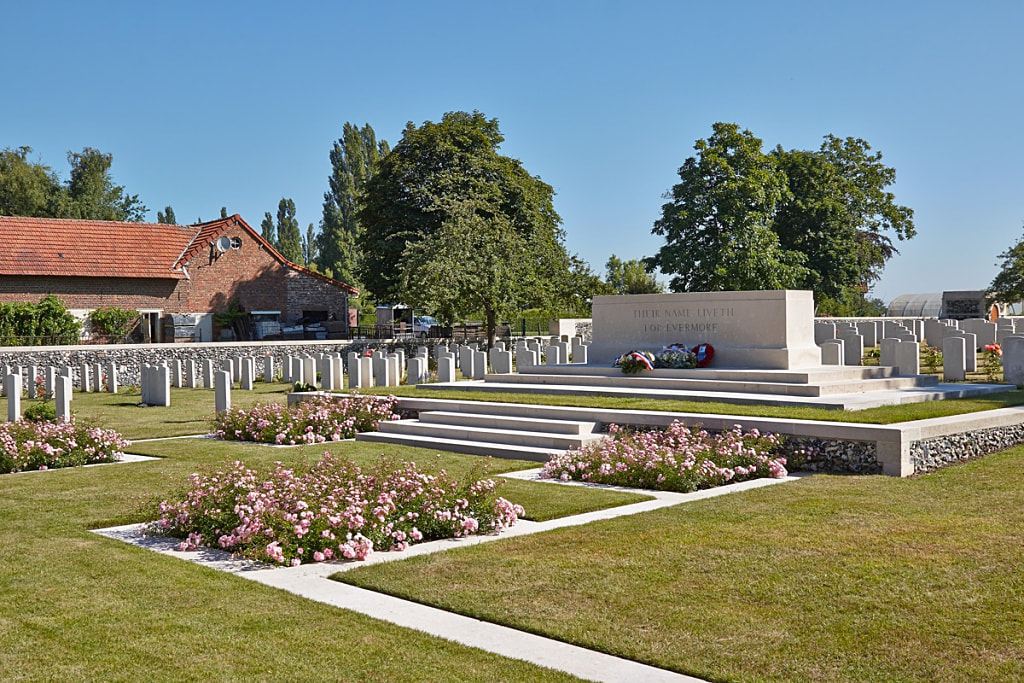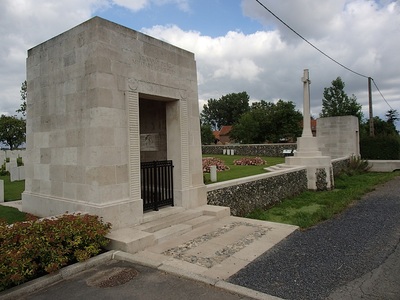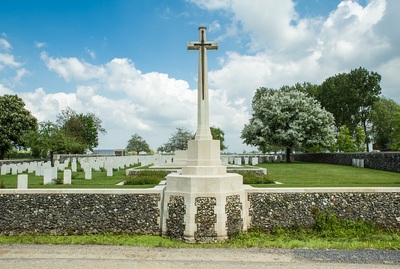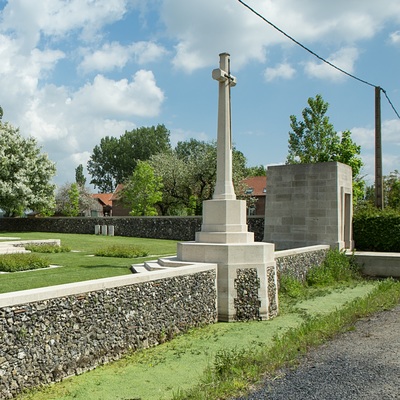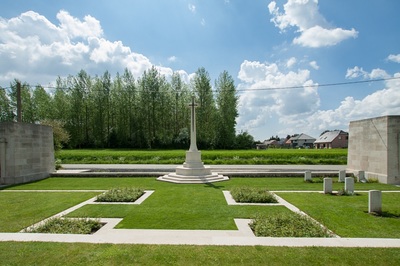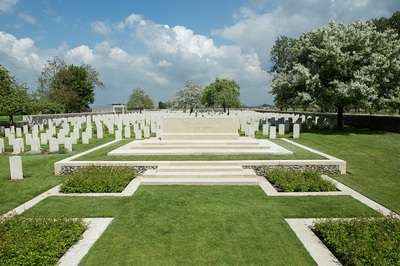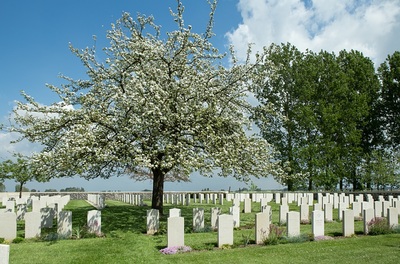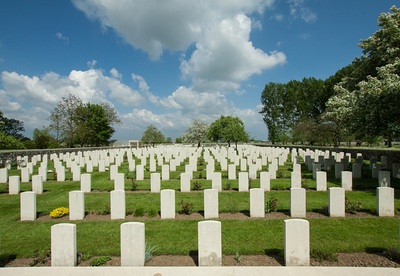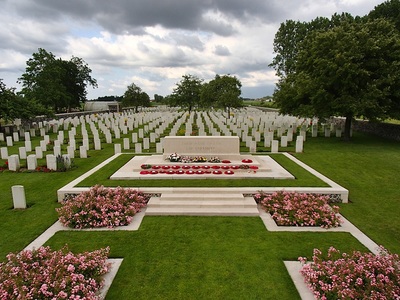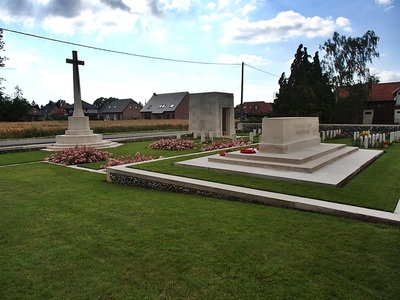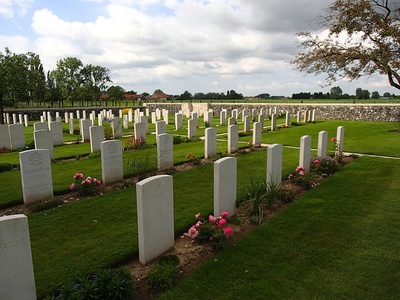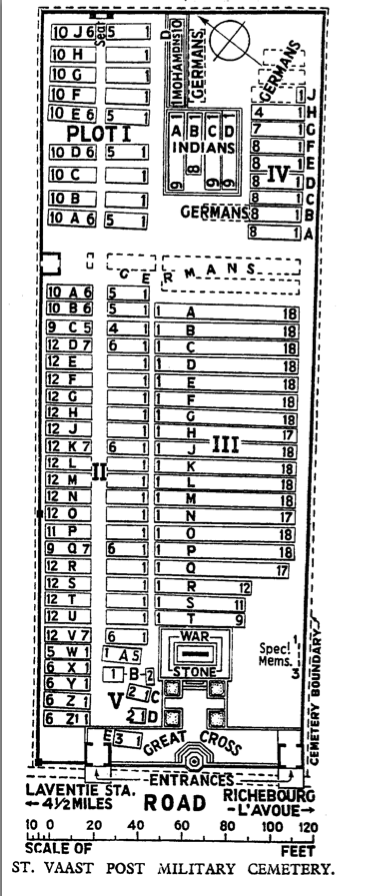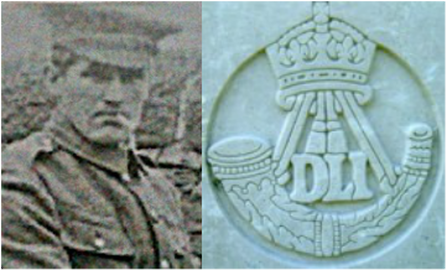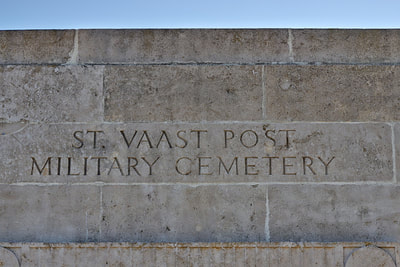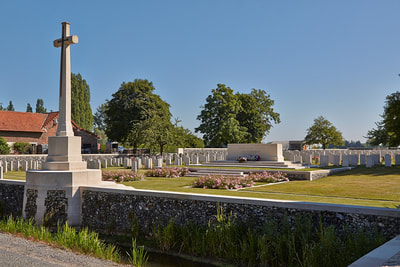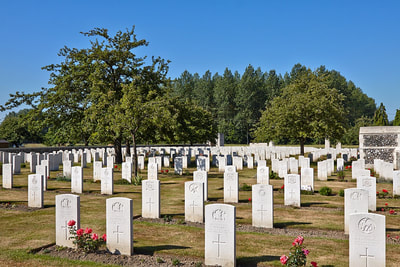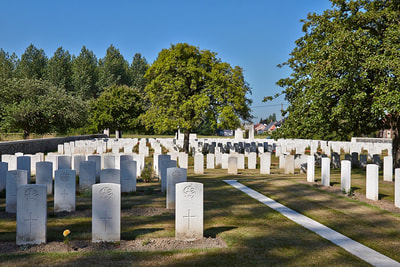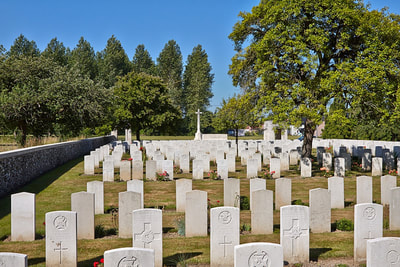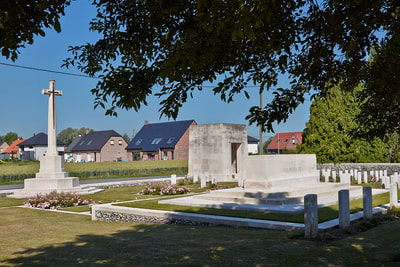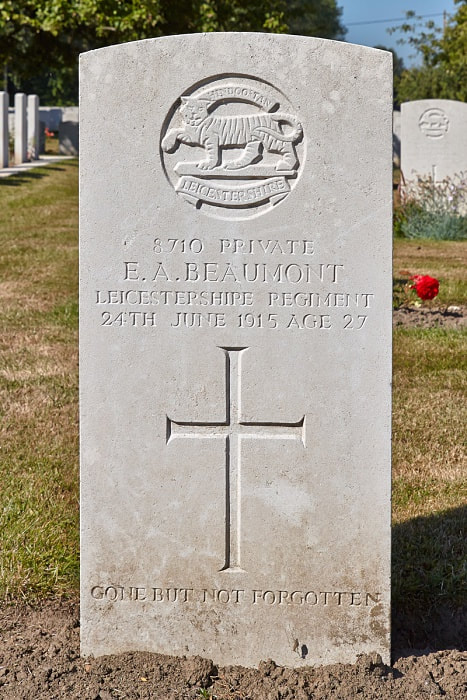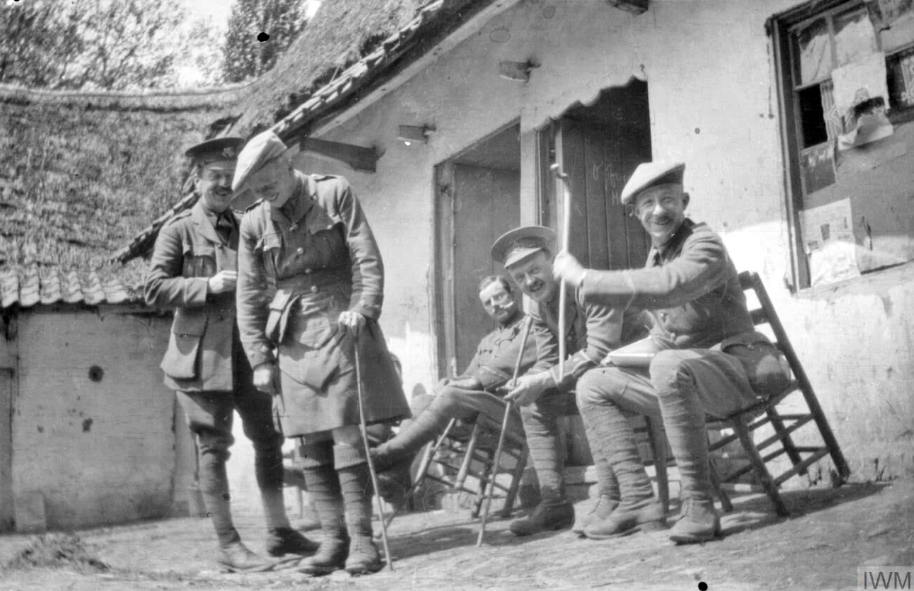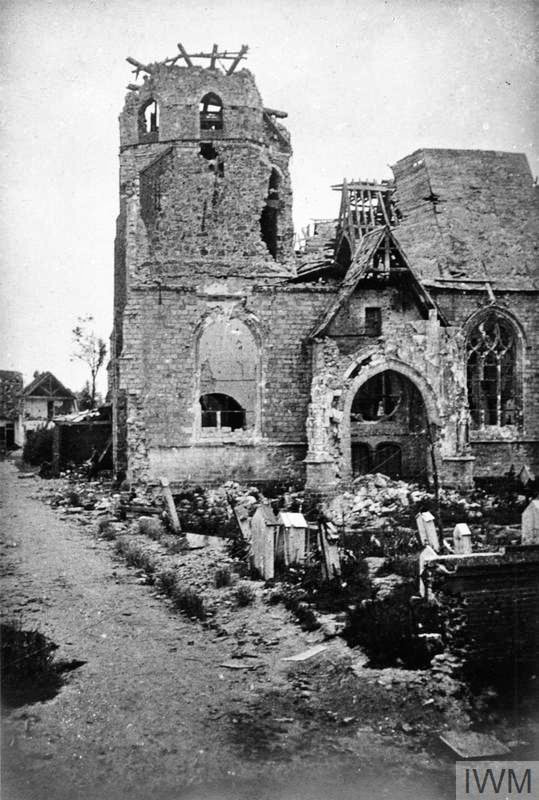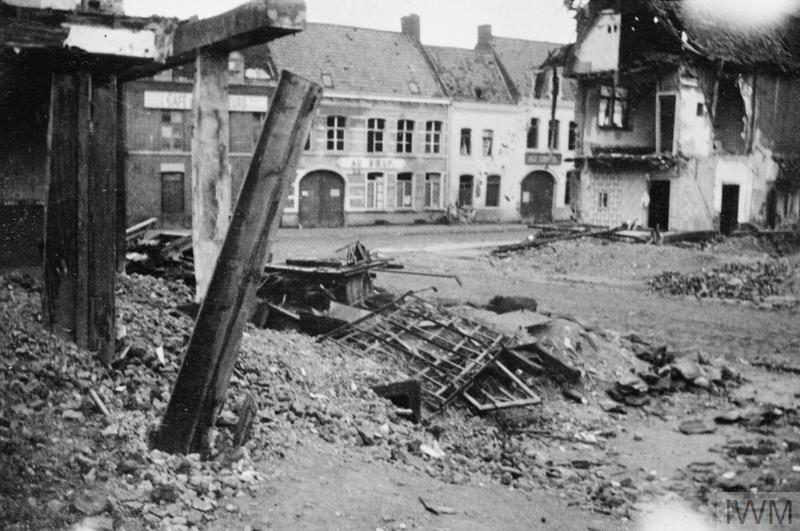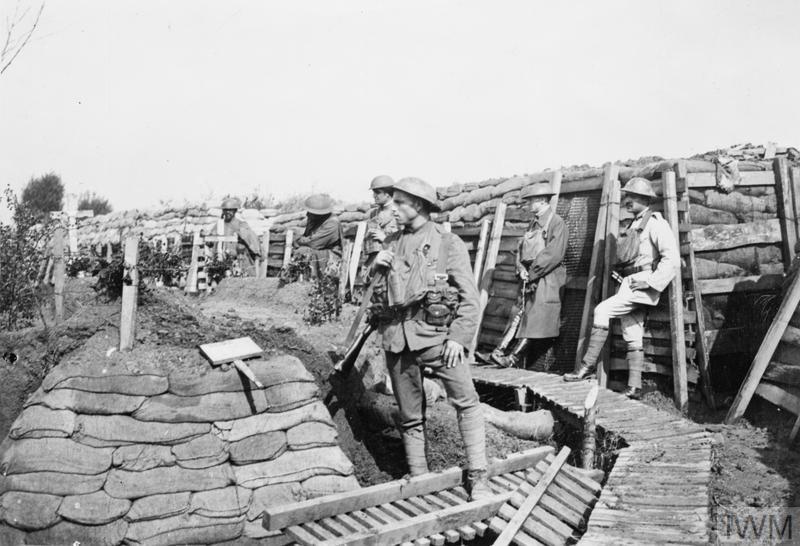ST. VAAST POST MILITARY CEMETERY
Richebourg-L'Avoue
Pas De Calais
France
GPS Coordinates - Latitude: 50.5845, Longitude: 2.74871
Location Information
St. Vaast Post Military cemetery lies near the village of Richebourg-l'Avoue which is 9 kilometres north-east of Bethune. From Bethune follow the D.171 toward Armentieres and progress onto the D.166 proceeding into the outskirts of Richebourg. Take a left turning into Rue des Charbonniers for approximately 2 kilometres and the cemetery is on the right hand side.
Visiting Information
Wheelchair access to this cemetery is possible with some difficulty.
Historical Information
St. Vaast Post Military Cemetery, Richebourg L’Avoué
The village of Richebourg-L'Avoué was held by British forces from the autumn of 1914 until it was overrun by German units advancing west during the great Spring Offensive in April 1918. It was recaptured by Commonwealth soldiers in September 1918 and remained in Allied hands until the end of the war. The village was less than two kilometres from the front-lines trenches and was routinely shelled by German artillery.
During the Battle of Festubert in May 1915, British soldiers began burying their fallen comrades in an old orchard near a forward dressing station which was located at the terminus of a trench tramway between the hamlet of Richebourg St. Vaast and La Croix Barbet. The cemetery was used by fighting units serving in the front-line and field ambulances until July 1917 and is the final resting place of over 70 men of the South Downs Pals battalion who were killed at the Battle of Boar’s Head on 30 June 1916. In April and May 1918, the Germans buried 90 of their dead in the south-east end of the cemetery and in September and October 1918, 18 British soldiers killed during the final Allied advance were laid to rest in Plot V. There are now almost 800 soldiers of the First World War buried or commemorated at St. Vaast Post, including over 90 German burials. Special memorials have been erected to three British soldiers buried in the cemetery whose graves cannot now be traced.
The South Downs Pals and the Battle of Boar’s Head
Major logistical preparations for the Anglo-French Somme Offensive had been ongoing for much of the first half of 1916. In order to disguise the exact location of the offensive and prevent the German forces from sending reinforcements to the Somme, the British High Command decided that a number of diversionary operations should be staged elsewhere along the front just before and during the main battle. One such attack took place early in the morning of 30 June and focused on the German lines opposite Richebourg L’Avoué, including the Boar’s Head salient. The salient had been formed during the Battle of Aubers Ridge in 1915 and gave the Germans a vantage point from which they could bombard the British forward positions with trench mortars and rifles grenades and fire on patrols and wiring parties working in no man’s land. The British units selected for the attack were the 11th, 12th, and 13th Battalions of the Royal Sussex Regiment, otherwise known as the 1st, 2nd and 3rd ‘South Downs Pals’. Few of the officers and men had any experience of combat on the Western Front and they would be facing a well organised and determined enemy.
The date of the attack had to be delayed due to the brief postponement of the main Somme offensive further south, but the Sussex men finally left their positions at zero hour just after 3.05 am on 30 June and advanced through the smoke and half-light towards the German positions. The men of the 12th and 13th battalions led the attack and immediately came under heavy rifle and machine gun fire. Some of them nonetheless managed to fight their way through the German wire and occupy the front-line trenches. They held this captured territory for about four hours before they were forced to return to their own lines in the face of fierce German counter attacks. Over the course of less than five hours of fighting the three South Downs Pals battalions suffered approximately 1000 casualties, over 360 of whom had been killed.
Casualty Details: UK 744, India 55, Germany 91, Total Burials: 890.
The cemetery was designed by Charles Henry Holden & Noel Ackroyd Rew
St. Vaast Post Military cemetery lies near the village of Richebourg-l'Avoue which is 9 kilometres north-east of Bethune. From Bethune follow the D.171 toward Armentieres and progress onto the D.166 proceeding into the outskirts of Richebourg. Take a left turning into Rue des Charbonniers for approximately 2 kilometres and the cemetery is on the right hand side.
Visiting Information
Wheelchair access to this cemetery is possible with some difficulty.
Historical Information
St. Vaast Post Military Cemetery, Richebourg L’Avoué
The village of Richebourg-L'Avoué was held by British forces from the autumn of 1914 until it was overrun by German units advancing west during the great Spring Offensive in April 1918. It was recaptured by Commonwealth soldiers in September 1918 and remained in Allied hands until the end of the war. The village was less than two kilometres from the front-lines trenches and was routinely shelled by German artillery.
During the Battle of Festubert in May 1915, British soldiers began burying their fallen comrades in an old orchard near a forward dressing station which was located at the terminus of a trench tramway between the hamlet of Richebourg St. Vaast and La Croix Barbet. The cemetery was used by fighting units serving in the front-line and field ambulances until July 1917 and is the final resting place of over 70 men of the South Downs Pals battalion who were killed at the Battle of Boar’s Head on 30 June 1916. In April and May 1918, the Germans buried 90 of their dead in the south-east end of the cemetery and in September and October 1918, 18 British soldiers killed during the final Allied advance were laid to rest in Plot V. There are now almost 800 soldiers of the First World War buried or commemorated at St. Vaast Post, including over 90 German burials. Special memorials have been erected to three British soldiers buried in the cemetery whose graves cannot now be traced.
The South Downs Pals and the Battle of Boar’s Head
Major logistical preparations for the Anglo-French Somme Offensive had been ongoing for much of the first half of 1916. In order to disguise the exact location of the offensive and prevent the German forces from sending reinforcements to the Somme, the British High Command decided that a number of diversionary operations should be staged elsewhere along the front just before and during the main battle. One such attack took place early in the morning of 30 June and focused on the German lines opposite Richebourg L’Avoué, including the Boar’s Head salient. The salient had been formed during the Battle of Aubers Ridge in 1915 and gave the Germans a vantage point from which they could bombard the British forward positions with trench mortars and rifles grenades and fire on patrols and wiring parties working in no man’s land. The British units selected for the attack were the 11th, 12th, and 13th Battalions of the Royal Sussex Regiment, otherwise known as the 1st, 2nd and 3rd ‘South Downs Pals’. Few of the officers and men had any experience of combat on the Western Front and they would be facing a well organised and determined enemy.
The date of the attack had to be delayed due to the brief postponement of the main Somme offensive further south, but the Sussex men finally left their positions at zero hour just after 3.05 am on 30 June and advanced through the smoke and half-light towards the German positions. The men of the 12th and 13th battalions led the attack and immediately came under heavy rifle and machine gun fire. Some of them nonetheless managed to fight their way through the German wire and occupy the front-line trenches. They held this captured territory for about four hours before they were forced to return to their own lines in the face of fierce German counter attacks. Over the course of less than five hours of fighting the three South Downs Pals battalions suffered approximately 1000 casualties, over 360 of whom had been killed.
Casualty Details: UK 744, India 55, Germany 91, Total Burials: 890.
The cemetery was designed by Charles Henry Holden & Noel Ackroyd Rew

64364 Gunner
James Willie Barker
"C" Bty. 87th Bde. Royal Field Artillery
22nd March 1916, aged 29.
Plot II. U. 12
Husband of Betsy Barker, of Burnt Acres Farm, Eastwood, Todmorden.
Picture courtesy of Jerry Cockeram
James Willie Barker
"C" Bty. 87th Bde. Royal Field Artillery
22nd March 1916, aged 29.
Plot II. U. 12
Husband of Betsy Barker, of Burnt Acres Farm, Eastwood, Todmorden.
Picture courtesy of Jerry Cockeram
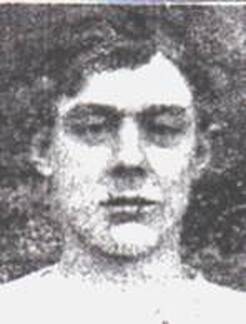
Private S/5040
James M. Borland
2nd Bn. The Black Watch (Royal Highlanders)
11th July 1915, aged 23.
Plot I. C. 10.
Husband of Marion Borland, of 47, Johnstone St., Airdrie.
Image courtesy of Joe O'Raw and William Kilgour
James M. Borland
2nd Bn. The Black Watch (Royal Highlanders)
11th July 1915, aged 23.
Plot I. C. 10.
Husband of Marion Borland, of 47, Johnstone St., Airdrie.
Image courtesy of Joe O'Raw and William Kilgour
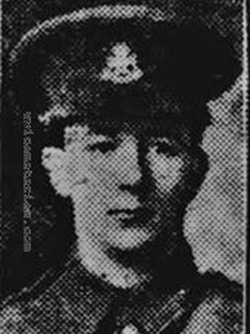
31860 Private
W. Geary
15th Bn. Sherwood Foresters
(Notts and Derby Regiment)
30th May 1916
Plot III. J. 7.
W. Geary
15th Bn. Sherwood Foresters
(Notts and Derby Regiment)
30th May 1916
Plot III. J. 7.
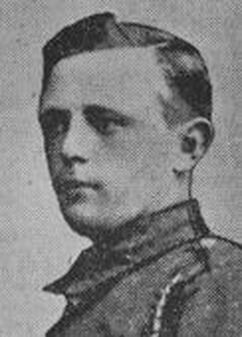
15783 Corporal
Frank Haslem
"B" Company, 11th Bn. East Lancashire Regiment
6th August 1916, aged 24.
Plot III. B. 17.
Son of Ellis and Louisa Haslem, of 10, Maple St., Clayton-le-Moors, Accrington.
His headstone bears the inscription: "In God's Most Holy Keeping."
Frank Haslem
"B" Company, 11th Bn. East Lancashire Regiment
6th August 1916, aged 24.
Plot III. B. 17.
Son of Ellis and Louisa Haslem, of 10, Maple St., Clayton-le-Moors, Accrington.
His headstone bears the inscription: "In God's Most Holy Keeping."
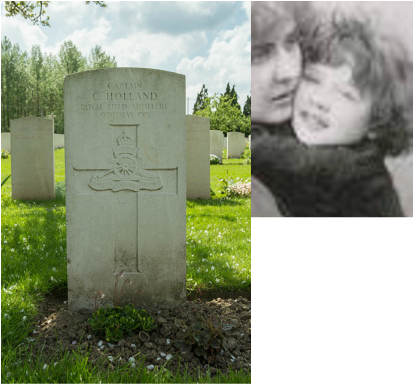
Captain
Cyril Holland
13th Bde. Meerut Division, Royal Field Artillery
9th May 1915, aged 29.
Plot I. A. 1.
Son of Oscar Wilde and Constance Lloyd.
Eldest son of playwright and poet Oscar Wilde, and Constance Lloyd Wilde, later Holland.
Dedicated by the Granddaughter of a woman who loved him dearly.
"To a wonderfully brave man who sacrificed nine years of seniority to fight here and died redeeming his families name."
Picture of grave © Werner Van Caneghem
Cyril Holland
13th Bde. Meerut Division, Royal Field Artillery
9th May 1915, aged 29.
Plot I. A. 1.
Son of Oscar Wilde and Constance Lloyd.
Eldest son of playwright and poet Oscar Wilde, and Constance Lloyd Wilde, later Holland.
Dedicated by the Granddaughter of a woman who loved him dearly.
"To a wonderfully brave man who sacrificed nine years of seniority to fight here and died redeeming his families name."
Picture of grave © Werner Van Caneghem
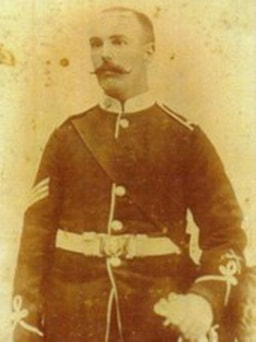
3/256 Company Quartermaster Serjeant
Simon Merritt
6th Bn. Wiltshire Regiment
25th December 1915, aged 44.
Plot II. J. A.
Son of Thomas Merritt, of Bishop's Cannings, Devizes; husband of Matilda J. Willis (formerly Merritt).
Picture courtesy of his Granddaughter Sylvia Merritt
Simon Merritt
6th Bn. Wiltshire Regiment
25th December 1915, aged 44.
Plot II. J. A.
Son of Thomas Merritt, of Bishop's Cannings, Devizes; husband of Matilda J. Willis (formerly Merritt).
Picture courtesy of his Granddaughter Sylvia Merritt
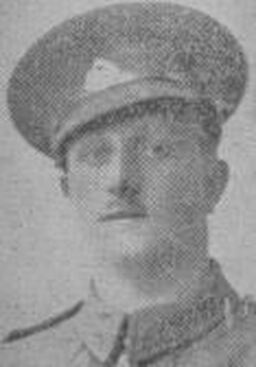
17875 Lance Corporal
John Pickup
11th Bn. East Lancashire Regiment
5th August 1916.
Plot III. Q. 15
John Pickup
11th Bn. East Lancashire Regiment
5th August 1916.
Plot III. Q. 15
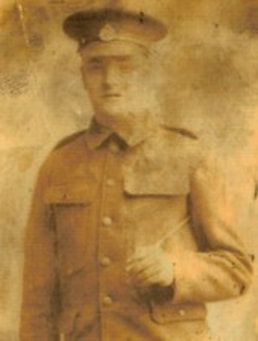
5759 Private
Myles Sweeney
7th Bn. East Lancashire Regiment
6th April 1916.
Plot III. B. 4
Picture courtesy of Craig Simpson, great grand nephew
Myles Sweeney
7th Bn. East Lancashire Regiment
6th April 1916.
Plot III. B. 4
Picture courtesy of Craig Simpson, great grand nephew

479 Private
Alfred R. Turner
11th Bn. Royal Sussex Regiment
23rd June 1916, aged 28.
Plot III. N. 5.
Son of Mrs. Mary J. Turner, of Horeham Flat Farm, Horeham Road, Sussex.
His headstone bears the inscription: "Rest In Peace."
Alfred R. Turner
11th Bn. Royal Sussex Regiment
23rd June 1916, aged 28.
Plot III. N. 5.
Son of Mrs. Mary J. Turner, of Horeham Flat Farm, Horeham Road, Sussex.
His headstone bears the inscription: "Rest In Peace."
Pictures in gallery below © Geerhard Joos
Shot at Dawn
8710 Private Ernest Alfred Beaumont, 2nd Bn. Leicestershire Regiment, executed for desertion 24th June 1915, aged 27. Plot I. G. 1. Son of James William and Annie Beaumont, of 35, Russell St., Hills Rd., Cambridge. He had been in France since October 1914, but on 14 March 1915 absented himself when travelling from Le Havre to rejoin his unit, only to be arrested in Rouen on May 4. (Putkowski, p.45)
8710 Private Ernest Alfred Beaumont, 2nd Bn. Leicestershire Regiment, executed for desertion 24th June 1915, aged 27. Plot I. G. 1. Son of James William and Annie Beaumont, of 35, Russell St., Hills Rd., Cambridge. He had been in France since October 1914, but on 14 March 1915 absented himself when travelling from Le Havre to rejoin his unit, only to be arrested in Rouen on May 4. (Putkowski, p.45)

